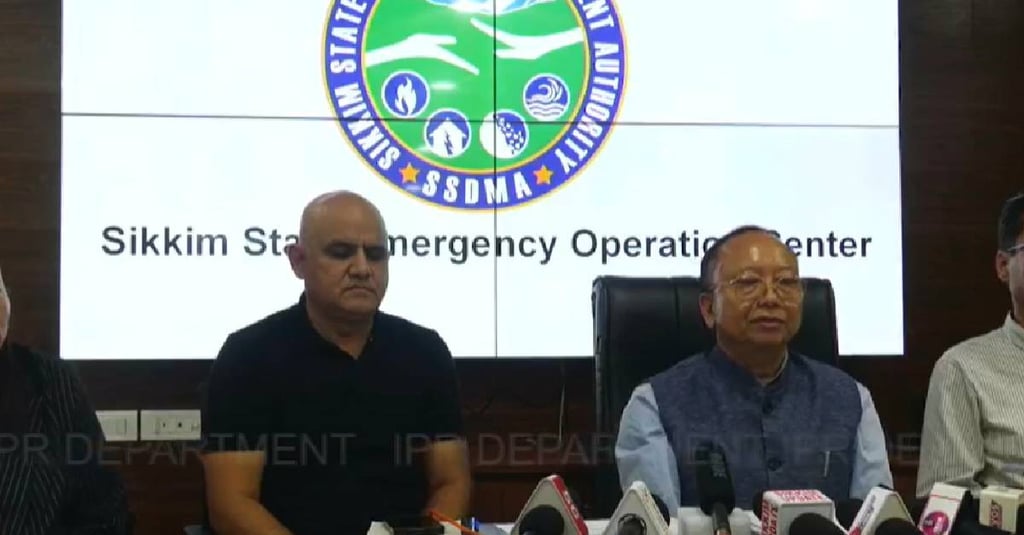Heavy rains hit North Sikkim, rescue operations ongoing, says Mingma T. Sherpa
Sherpa assured the public that the state has enough funds to manage the relief and rehabilitation work.
LOCAL


Mingma T. Sherpa, IAS, Relief Commissioner-cum-Secretary of the Land Revenue & Disaster Management Department, Government of Sikkim, today held a detailed press conference to update the public on the severe natural calamity that struck Mangan district in North Sikkim on the night of May 30. The disaster brought heavy rains, landslides, and the collapse of roads and bridges, causing major disruption to the daily lives of people and infrastructure in the region.
According to Sherpa, the heavy rains caused multiple roadblocks and damaged several bridges between Chungthang, Lachen, Lachung, and nearby areas. The water level of the Teesta River rose sharply and crossed the danger mark, making it difficult to travel and transport goods. Road connectivity from Singtam to Lachen and Lachung was cut off on May 31, leading to serious challenges for the people living in these areas.
The state government responded immediately by informing the Prime Minister’s Office and the National Disaster Management Authority (NDMA) about the situation. Since the first day, relief efforts have been actively underway with the local administration, the Army, the Indo-Tibetan Border Police (ITBP), and other agencies joining forces to help the people in need.
On June 1, the government began airlifting stranded residents and tourists. About 1,807 tourists, including some who were sick, trapped in vehicles due to roadblocks, were rescued by June 2. Electricity and mobile networks were restored in most affected areas like Lachung and Chungthang, allowing communication to return to normal. As of June 3, 33 tourists were evacuated by helicopter, and teams from the National Disaster Response Force (NDRF) have been coordinating rescue work on the ground.
The Chief Minister and top officials, including the State Executive Committee chairman and the Director-General of Police, are closely monitoring the situation. The government confirmed that enough food, water, and medicines are available and ready to be distributed where needed. Though some areas like Chungthang still face difficulties due to landslides, other parts of Sikkim such as Gangtok, West Sikkim (Pelling and Geyzing), Namchi district, and Nathula Pass are safe and open for tourists and residents.
Sherpa said that the government has declared the event a disaster under the Disaster Management Act of 2005. The damage to four or five bridges between Chungthang and Lachen is significant and it will take time to rebuild. However, the government has taken all necessary steps to restore infrastructure and support the people as quickly as possible.
The press conference also highlighted ongoing scientific work to monitor glaciers and lakes vulnerable to flooding. This comes after last year’s Glacial Lake Outburst Flood (GLOF) incident in Sikkim. The authorities, with help from national and international agencies, use automated weather stations to gather real-time information on water levels and weather conditions at these high-risk lakes. This monitoring system helps detect any sudden changes early, giving valuable time for warning and evacuation.
The Relief Commissioner praised the efforts of local authorities, Army personnel, ITBP and NDRF teams for their round-the-clock work in difficult conditions to rescue people safely. The local police have also put in place an advanced warning system with sirens and public announcements to alert people when river levels rise, helping them evacuate before danger increases.
Sherpa assured the public that the state has enough funds to manage the relief and rehabilitation work. The Government of India has also promised additional financial support if required. He stressed that the focus is not on seeking funds but on declaring the disaster officially to ensure proper help and coordination for the affected people.
The government is planning further damage assessments and will continue to provide assistance to those still stranded, especially in and around Lachen. The area is expected to fully reopen by July after restoration works.
The Relief Commissioner advised people to stay calm and not panic. He encouraged tourists to visit other safe parts of Sikkim and assured residents that the government is doing everything possible to handle the situation carefully and efficiently.
